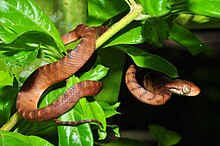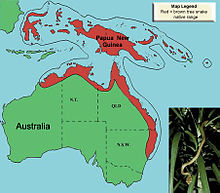棕树蛇
棕树蛇(学名:Boiga irregularis;英语:brown tree snake)是林蛇属下的一种树栖蛇,原产于澳大利亚东部和北部沿海、印度尼西亚东部、巴布亚新几内亚和美拉尼西亚西部多个岛屿上。棕树蛇因为入侵关岛并对当地鸟类繁衍造成毁灭性的打击而闻名。[1]国际自然保护联盟物种存续委员会的入侵物种专家小组(ISSG)列为世界百大外来入侵种。
| 棕树蛇 | |
|---|---|

| |
| 科学分类 | |
| 界: | 动物界 Animalia |
| 门: | 脊索动物门 Chordata |
| 纲: | 爬行纲 Reptilia |
| 目: | 有鳞目 Squamata |
| 亚目: | 蛇亚目 Serpentes |
| 科: | 游蛇科 Colubridae |
| 属: | 林蛇属 Boiga |
| 种: | 棕树蛇 B. irregularis
|
| 二名法 | |
| Boiga irregularis Merrem, 1802
| |

| |
| 异名 | |
|
Coluber irregularis Merrem, 1802 | |
特征与习性 编辑
虽然是树栖蛇,但棕树蛇也会出现在草地和稀疏林地。在巴布亚新几内亚,其活动范围最高为海拔1,200米(3,900英尺)。[2]一般在夜间到地面捕食,白天则躲在树冠、空木、岩隙甚至是房檐下的阴暗角落里。[3][4]棕树蛇一般体长1—2米(3.3—6.6英尺),蛇身细长可以迅速通过狭小的缝隙。身体颜色从褐色到黄绿色不等,也有带红色斑点的米黄色个体。[4]可以长期不吃东西。[4]
食物 编辑
棕树蛇的食物包括鸟类、蜥蜴、蝙蝠和小型啮齿动物。[5][6]因此有时也会袭击家禽及笼鸟。[7]
因为缺乏天敌且有丰富的食物来源,入侵关岛的棕树蛇的体型愈来愈大,超过了正常的1—2米(3.3—6.6英尺)。[5]在关岛记录中最大的棕树蛇可长到3米(9.8英尺)。[5]
繁衍 编辑
棕树蛇的繁衍并没有得到深入研究。[5]雌性的会产下4-12枚椭圆形的卵。[2][5]依据气候和食物丰富程度,雌性每年可产卵一至二次。[5]产卵地点选择在空木、岩隙和其他可以抵御高温和干燥的地点。[5][8]某些情况下,雌性棕树蛇可在交配后将受精卵储存在体内数年之久。[4]
毒液 编辑
棕树蛇受到威胁时就会变得极具攻击性,[5]在嘴的后部有两个较小的毒牙,其表面有沟槽。[9]由于其毒牙并不是中空构造,因此造成咬伤时也只有少量的毒液会进入猎物体内。毒液具有微弱的神经毒性,可能也有细胞毒性。对成年男性影响很小,而儿童会有较强的反应。[5][9]
入侵物种 编辑
1952年棕树蛇突然出现在关岛,原因可能是货船运输。[5][9]对棕树蛇来说,这里有丰富的食物来源,并且在当地除去红树巨蜥和野猪之外再无天敌,关岛上的棕树蛇数量开始急剧增加。[5]造成了许多当地物种灭绝以及数千起断电等事故,给当地居民的生活造成了相当的不便。[5]而关岛作为西太平洋地区海运枢纽,与其有联系的其他诸岛因此也面临著棕树蛇入侵的威胁。[5]为解决这一问题,当地政府专门训练了警犬来搜寻可能藏身于货船上的棕树蛇。[10]不过虽然如此,还是在威克岛、天宁岛、罗塔岛、冲绳县、迪戈加西亚岛和夏威夷发现了其踪迹,甚至连美国本土的德克萨斯州也有报导发现棕树蛇。[11]而塞班岛上的棕树蛇已经有了扩张的迹象。[5]
现在关岛上的棕树蛇数量已经开始下降,平均每公顷约有30至50条棕树蛇。[12]原因可能是食物来源减少及人类捕杀。[12]
数量控制 编辑
目前棕树蛇有2种天敌已被确认,即红腹伊澳蛇和剧毒的海蟾蜍。此外还有55种潜在的天敌。[13]但因为其天敌本身侵略性较强,因此引入天敌并不是控制其数量的好方法。[14]
参考文献 编辑
- ^ Invasive Species: Animals - Brown Tree Snake (页面存档备份,存于互联网档案馆), National Agricultural Library, United States Department of Agriculture, Retrieved 2010-08-31
- ^ 2.0 2.1 Bomford, M; F.Kraus. Predicting establishment for alien reptiles and amphibians: a role for climate matching.. 11:713-724. Biological Invasions. 2008.
- ^ Campbell, S.R.; S.P. Mackessy. Microhabitat use by Brown Treesnakes (Boiga irregularis): Effects of moonlight and prey.. 42(2):246-250. Journal of Herpetology. 2008.
- ^ 4.0 4.1 4.2 4.3 Fritts, T.H.; G.H. Rodda. The role of introduced species in the degradation of island ecosystems: A case history of Guam.. 29:113-140. Annual Review of Ecology and Systematics. 1998.
- ^ 5.00 5.01 5.02 5.03 5.04 5.05 5.06 5.07 5.08 5.09 5.10 5.11 5.12 5.13 Fritts, T.H.; D. Leasman-Tanner. The Brown Treesnake on Guam: How the arrival of one invasive species damaged the ecology, commerce, electrical systems, and human health on Guam: A comprehensive information source. U.S. Department of the Interior. 2001 [2008-09-11]. (原始内容存档于2008-12-07).
- ^ Pianka, Eric R.; King, Dennis; King, Ruth Allen. (2004). Varanoid Lizards of the World. Indiana University Press, 588 pages ISBN 0-253-34366-6
- ^ D'Evelyn, S.T.; N. Tauri. Learning-by-catching: Uncertain invasive-species populations and the value of information.. 89(4):284-292(2). Journal of Environmental Management. 2008.
- ^ Savidge, Julie, Fiona Qualls, and Gordon Rodda. "Reproductive Biology of the Brown Tree Snake, Boiga Irregularis (Reptilia: Colubridae), During Colonization of Guam and Comparison with That in Their Native Range." Pacific Science, 61.2 (2007): 191-199.
- ^ 9.0 9.1 9.2 Mehrtens, John. Living Snakes of the World in Color. New York: Sterling. 1987. ISBN 0-8069-6461-8.
- ^ Vice, Daniel. Working Dogs: The Last Line of Defense for Preventing Dispersal of Brown Tree Snakes from Guam.
- ^ Kraus, Fred. ALIEN SPECIES. Department of Land and Natural Resources State of Hawaii. 2004 [2008-09-11]. (原始内容存档于2008-08-02).
- ^ 12.0 12.1 Mortensen, H.S.; Y.L. Dupont. snake in paradise: Disturbance of plant reproduction following extirpation of bird flower-visitors on Guam.. 141(8):2146-2154. Biological Conservation. 2008.
- ^ Caudell, J.N.; M.R. Conover. "Predation of brown tree snakes (Boiga irregularis) in Australia.. 49(2-3):107-111. International Biodeterioration & Biodegradation. 2001.
- ^ Burnett, K.M.; S. D'Evelyn. " Beyond the lamppost: Optimal prevention and control of the Brown Tree Snake in Hawaii. 67(1):66-74. Ecological Economics. 2008.
- ^ Engeman, R.A.; M.A. Linnell. The effect of trap spacing on the capture of brown tree snakes on Guam. USDA National Wildlife Research Center. 2003.
外部链接 编辑
- Species Profile- Brown Tree Snake (Boiga irregularis) (页面存档备份,存于互联网档案馆), National Invasive Species Information Center, United States National Agricultural Library. Lists general information and resources for brown tree snake.
警告:默认排序关键字“Brown Tree Snake”覆盖了之前的默认排序关键字“Boiga irregularis”。
